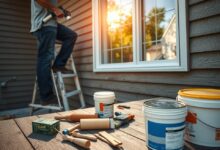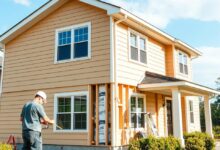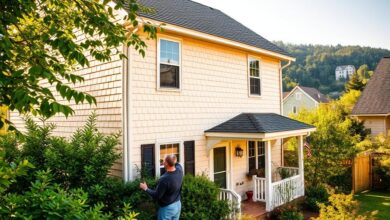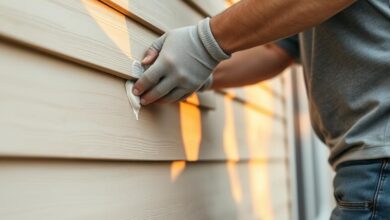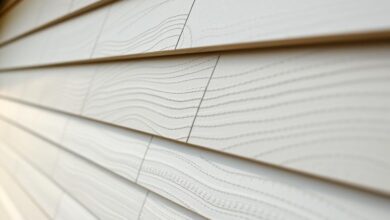Insulated Siding: Is It Worth the Cost?
Homeowners are always looking for ways to make their homes more energy efficient and durable. Insulated siding is becoming popular. It claims to cut down on energy costs and make homes look better.
With energy prices going up, people want to save money. Insulated siding is seen as a good option. It’s durable and helps save energy, unlike regular siding.
But, is insulated siding really worth the money? This article will look at the good and bad sides of insulated siding. We aim to help homeowners decide if it’s right for them.
Key Takeaways
- Insulated siding can improve a home’s energy efficiency.
- The cost of insulated siding varies depending on several factors.
- Homeowners can benefit from reduced energy costs with insulated siding.
- The durability of insulated siding is a significant advantage.
- Proper installation is key for the best results.
What Is Insulated Siding and How Does It Work?
Insulated siding is a new way to cover your home’s exterior. It’s strong and saves energy. It makes your home look better and feel warmer.
It’s not just about looks. Insulated siding saves energy and keeps your home cozy. It stops heat from moving in and out.
The Structure and Components of Insulated Siding
Insulated siding has layers. There’s a tough outer layer, a foam core, and a backing. The foam insulation core is key. It keeps the heat in or out.
The outer layer is made to last. It fights off weather and keeps your siding looking good.
Popular Types and Brands of Insulated Siding
There are many types and brands of insulated siding. You can pick from vinyl insulated siding and foam-backed siding. Masonite and CertainTeed are top choices.
You can choose from many styles and colors. This lets you match your siding to your home’s look.
Understanding R-Values and Thermal Performance
The R-value shows how well siding keeps heat. A higher R-value means better insulation. This means less heat loss in winter and less heat gain in summer.
Knowing about R-values helps you choose the right siding. This can save you a lot on energy bills.
The Benefits of Installing Insulated Siding
Insulated siding brings many advantages to homeowners. It saves energy, lasts longer, and looks great. It also helps manage moisture, keeping homes dry and healthy.
Energy Efficiency and Utility Bill Savings
Insulated siding makes homes more energy-efficient. It keeps warmth in during winter and cool air in during summer. This means lower bills for heating and cooling.
Energy efficiency is also eco-friendly. It cuts down on carbon emissions, helping the planet.
Noise Reduction Properties
It also reduces noise. The insulation layer absorbs sound, making homes quieter. This is perfect for those living in noisy areas.
Enhanced Durability and Impact Resistance
Insulated siding is tough and can handle harsh weather. It’s less likely to get damaged by wind, rain, or hail.
Aesthetic Appeal and Design Options
There are many styles and colors to choose from. Whether you want something modern or classic, you’ll find the right insulated siding.
Moisture Management and Mold Prevention
It also controls moisture and prevents mold. This protects homes from water damage and keeps them healthy.
Cost Analysis: Is Insulated Siding Worth It?
To figure out if insulated siding is a good choice, we need to look at the costs. We should consider the upfront costs, long-term energy savings, and how it affects home value and maintenance. This helps us understand if it’s a smart investment.
Initial Installation Costs vs. Standard Siding
Insulated siding costs more to install than regular siding. It can be $12 to $18 per square foot, while standard vinyl siding is $6 to $12. But, its durability and energy-saving features offer long-term benefits.
Long-Term Energy Savings
Insulated siding is great for saving energy. It keeps your home warmer in winter and cooler in summer. This can cut your energy bills by up to 15%, saving money over time.
- Reduced Heating Costs: It keeps warmth in during cold months.
- Lower Cooling Costs: It also keeps your home cooler in summer.
- Potential Incentives: You might get rebates for making your home more energy-efficient.
Maintenance Requirements and Expenses
Insulated siding is durable and needs little upkeep. It’s less likely to get damaged by weather and doesn’t need frequent repairs. This can save you money on maintenance costs over time.
- It’s built to withstand wind, rain, and temperature changes.
- It’s resistant to mold and mildew, saving you money on treatments.
- It’s easy to clean, keeping your home looking good without extra effort.
Return on Investment and Home Value
Insulated siding can also increase your home’s value. Buyers like homes that save on energy, making them more comfortable and cost-effective. This can lead to a better return on investment when you sell your home.
In conclusion, though insulated siding costs more upfront, its long-term benefits are worth it. It saves energy, needs less maintenance, and boosts your home’s value.
Comparing Insulated Siding to Alternatives
Insulated siding is just one siding option for homeowners. It’s important to compare it with others. Homeowners should think about cost, durability, energy efficiency, and looks when choosing siding.
Traditional Vinyl Siding with Separate Insulation
Traditional vinyl siding with separate insulation is another choice. It can offer better insulation levels and types. But, it might cost more upfront and be harder to install.
Key considerations: The cost of materials and labor, energy efficiency, and how it affects the project timeline.
Fiber Cement and Other Premium Siding Options
Fiber cement siding and other premium materials are durable and look good. They might not be as insulated as insulated siding but can be paired with insulation. These materials are pricier than vinyl but last longer and need less upkeep.
- Fiber cement siding for durability and resistance to pests and fire
- Premium siding options for enhanced aesthetic appeal
- Potential for pairing with insulation for improved energy efficiency
Who Benefits Most from Insulated Siding
Insulated siding is good for many homeowners. But, it’s even better for certain groups.
Climate Considerations
Those living in extreme weather can save a lot with insulated siding. It keeps the temperature inside steady, which can cut down on heating and cooling costs.
Home Age and Current Insulation
Older homes with bad insulation can benefit from insulated siding. It’s a cost-effective way to improve energy efficiency without big renovations. Homeowners should check their insulation and see if insulated siding can help.
Budget and Long-Term Planning
Those planning to stay in their home long-term might find insulated siding appealing. It costs more upfront but can save money in the long run. It’s also durable and needs less upkeep.
In summary, insulated siding is a good choice for many. It balances energy efficiency, durability, and cost. By comparing it to other options and thinking about their own needs, homeowners can make a smart choice.
Conclusion: Making the Right Choice for Your Home
Thinking about insulated siding? It’s key to look at the good and the bad. It saves energy, cuts down on noise, and lasts longer. These points make it a smart pick for many homeowners.
Think about what your home needs. If you’re in a place with really hot or cold weather, or you want to save on bills, insulated siding is a good choice. Companies like CertainTeed and James Hardie make top-notch products that improve your home’s look and function.
Choosing insulated siding is a personal decision. Knowing the pros and cons helps you decide what’s best for your home. This way, you can pick the right option for you.



